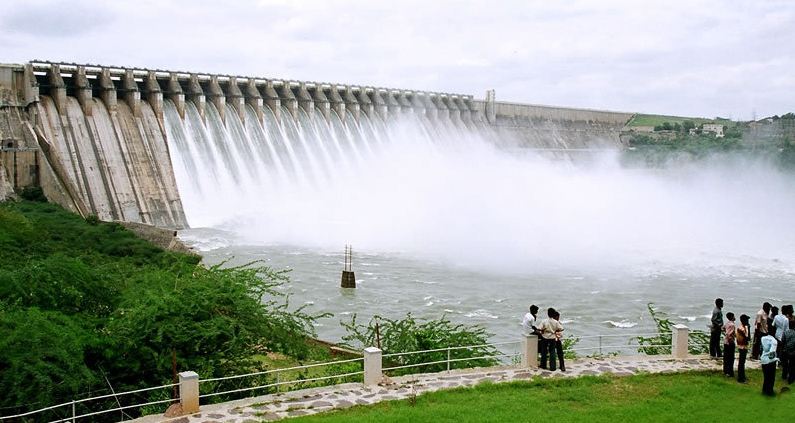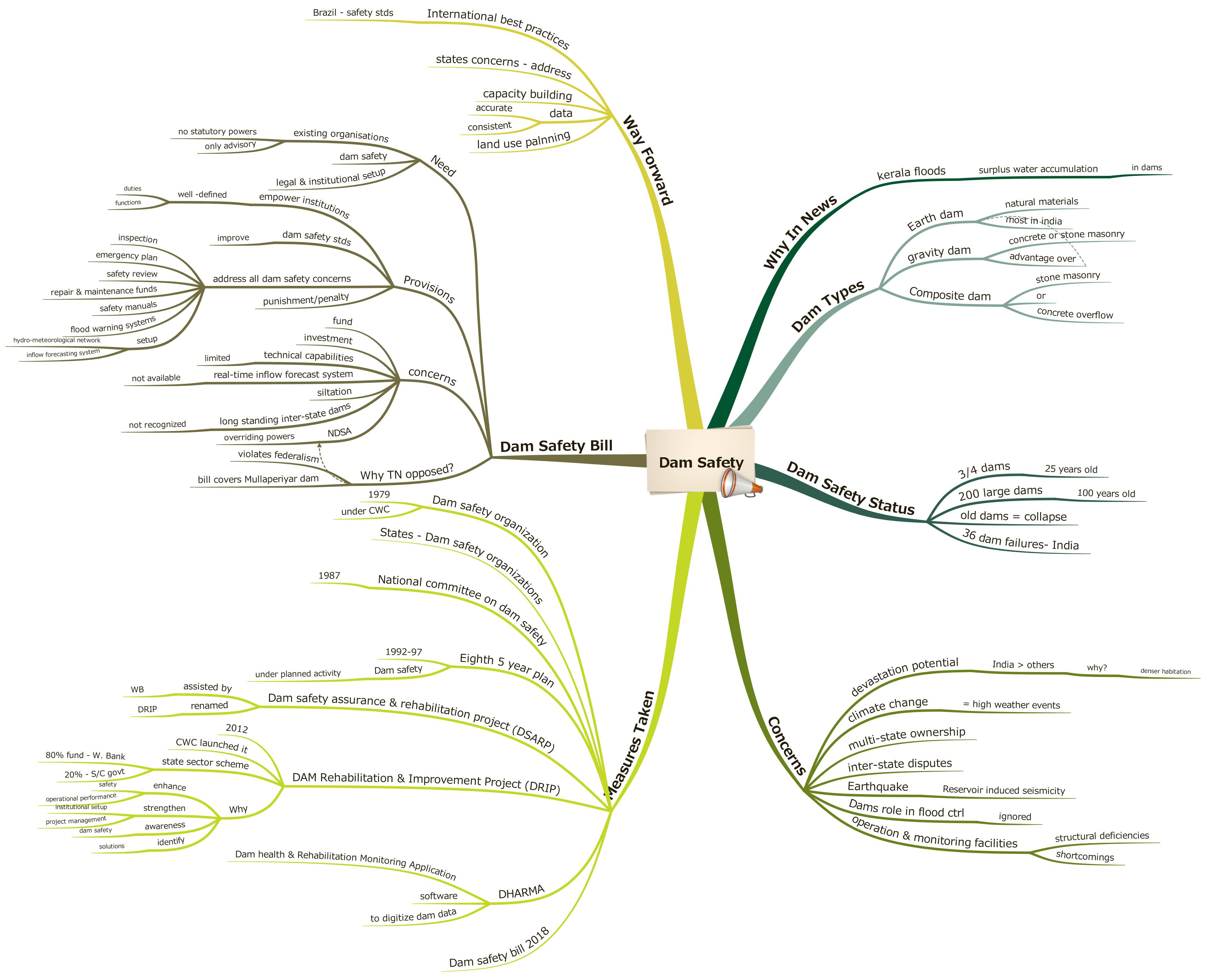Dam Safety in India – Issues and Analysis

From Current Affairs Notes for UPSC » Editorials & In-depths » This topic
IAS EXPRESS Vs UPSC Prelims 2024: 85+ questions reflected
Why in News?
The recent Kerala floods have highlighted the dangers of surplus water accumulation in dams. In this context, it is necessary to understand the role of dams in controlling floods and to analyze various measures taken by the government for dam safety in India.
What are the types of dams in India?
- Earth dam: Earthen dam uses natural materials with a minimal processing. Most of the dams in India are earthen dams.
- Gravity dam: Gravity dam is constructed with concrete or stone masonry and designed to hold back water by mainly using the material’s weight. Gravity dams have certain advantages over embankment dams.
- Composite dam: It is an earthen dam constructed with a stone masonry or concrete overflow (spillway) section.
What is the status of the dam safety in India?
- 3/4th of dams in India are over 25 years old.
- Majority of them exceeded their lifespan of 50 to 60 years and about 200 large dams are over 100 years of age.
- Since most of the old dams are constructed with mud, clay or other locally available materials, they are far more vulnerable to collapsing compared to the new generation concrete dams.
- There have already been as many as 36 dam failures, 9 of which have taken place after 2001.
Also Read: Digitization of land records – Critical Analysis
What are the concerns?
- The devastation potential of dam failures in India is far greater than other nations due to the denser habitation of the floodplains.
- The problem has increased with the increased frequency of weather events associated with climate change.
- The multi-state ownership and inter-state disputes over the maintenance and benefit-sharing of dams also contributing to this hazard. The Mullaperiyar dam, located in Kerala, but owned by Tamil Nadu, is the best example.
- There is also a case for reservoir induce seismicity (RIS) from the weight of the dams. This has resulted in earthquakes in different parts of the country.
- Moreover, the roles of dams in irrigation and power generation are acknowledged. However, its role in flood control has always been ignored. Dam authorities store the surplus monsoon water in dams and released during summer months for irrigation and power generation. But it is risky since the excess quantity leads to flooding causing loss of human lives, infrastructure, and agricultural land, as happened in Kerala.
- Many dams have varied structural deficiencies and shortcomings in operation and monitoring facilities.
What are the measures taken for ensuring dam safety in India?
- Dam safety is the responsibility of dam owners which are mostly state governments, central & state generating PSUs, municipalities and private companies.
- In 1979, the Union government had established a Dam Safety Organization in Central Water Commission (CWC) for helping states in assessing safety-related threats in existing dams.
- Later, 17 states with considerable numbers of dams had set up their own Dam Safety Organizations and undertook initiatives for assuring dam safety in their jurisdictions.
- In 1987, the Union government had established the National Committee on Dam Safety (NCDS) to act as a forum for discussing views on remedial measures to relieve distress in old dams.
- From the eighth 5 year plan (1992-97), dam safety was put under planned activity. Subsequently, Dam Safety Assurance & Rehabilitation Project (DSARP), assisted by the World Bank, was implemented.
- Later, DSARP was renamed as DAM Rehabilitation and Improvement Project (DRIP).
- In 2012, DRIP project was launched by Central Water Commission (CWC) under the Ministry of Water Resources, River Development & Ganga Rejuvenation.
- Government also launched DHARMA (Dam Health and Rehabilitation Monitoring Application), a software programme to digitize all dam-related data effectively.
- In 2018, the Union cabinet approved the proposal for introduction of Dam safety bill, 2018 in the parliament.
Dam Rehabilitation and Improvement Project (DRIP)
- Launched in 2012 by the Ministry of water resources.
- It is a state sector scheme with 80% of the total fund is given by World Bank as loan and the remaining 20% is borne by the States/central government.
- Objectives
- To enhance the safety and operational performance of selected dams.
- To strengthen the dam safety institutional setup and project management of participating states or implementing agencies.
- To bring greater awareness of dam safety issues and identifying novel solutions to solve them by pooling best knowledge, techs and experience around the world.
Dam Health and Rehabilitation Monitoring Application (DHARMA)
- It is a web-based asset management software to support the effective collection and management of asset and health data for all large dams in India.
- The software is designed for users at Central, State, and Dam level, with user permission rights governed by their respective licenses.
Dam Safety Bill, 2018
Need:
- Dam safety concerns discussed above.
- Lack of legal and institutional architecture for dam safety has raised fears over unsafe dams, and the possibility of consequent disasters and loss of life and property.
- The existing organizations such as NCDS, Central Dam Safety Organisation (CDSO) and State Dam Safety Organizations (SDSO) do not have any statutory powers and are only advisory in nature.
Key provisions
- It will empower the dam safety institutional set-ups in both the Centre and States.
- It will help in standardizing and improving dam safety practices across the country.
- It will address all issues concerning dam safety including regular inspection of dams, emergency action plan, comprehensive dam safety review, adequate repair and maintenance funds, and instrumentation & safety manuals.
- It will constitute the National Committee on Dam Safety (NCDS), National Dam Safety Authority (NDSA), and State Dam Safety Organization (SDSO) with well-defined duties and functions.
- It also provides for comprehensive safety evaluation (CSE) by an independent panel of experts. CSE will be compulsory for the major modification to structure or design criteria, the discovery of unusual condition at dam or reservoir rim and extreme hydrological or seismic event.
- It provides for punishment or penalty in case the dam safety provisions are not followed.
- The bill also proposes an emergency action plan to combat any disaster arising out of dam failures. The key provisions with respect to disaster management as follows
- Set up a hydro-meteorological network and inflow forecasting system.
- Set up an emergency flood warning system.
- Test periodically for the quality of the above systems.
- Make available information on anticipated inflows, outflows, flood warnings & adverse impacts to authorities and public domain
- Carry out risk assessment study at specified intervals. First such study within 5 years.
- Prepare an emergency action plan within 5 years and for new dams, before the initial filing.
- Emergency action plan to include type of emergencies that are likely to occur; likely flood in the event of dam failure, along with probable areas, population, structures and installations likely to be affected; warning procedures, inundation maps and advance preparations for handling adverse situations to avoid loss of human life; cooperation with disaster management agencies.
Key benefits
- It will help states and UTs in adopting uniform dam safety procedures.
- It will ensure the safety of dams thereby safeguarding human life, livestock, and property.
What are the concerns with the bill?
- Lack of fund
- Prioritizing investment with respect to risk
- States have very limited technical capabilities for assessing instrumentation data for investigation and detection of dam distress.
- Real-time inflow forecasting systems are not in place even in crucial reservoirs.
- Siltation of the reservoir is a serious concern, even though in several cases the extent of siltation continues to remain unknown. Desiltation of the reservoir is difficult in several cases due to environmental concerns regarding sediment disposal.
- Some states raised objections that the bill does not recognize dams and reservoirs run by long-standing inter-state agreements.
- The bill gives overriding powers to the National Dam Safety Organization to inspect any dams, among others.
Why Tamil Nadu oppose the bill?
- The Tamil Nadu legislative assembly passed a resolution to oppose the Dam Safety Bill, 2018 proposed by the Central government.
- The resolution claims that all the states must be consulted and a consensus must be reached on the contents of the bill before it is passed by the Parliament.
- The TN government opposed the bill on the grounds that it overrode the federal nature of the constitution. The bill gives overriding power to NDSA over state committees on dam safety in case of Dams constructed by the State Government in the neighboring State. The state also has an objection to the bill’s coverage of Mullaperiyar dam.
What is the Mullaperiyar issue?
- Tamil Nadu owns dams in Mullaperiyar, Parambikulam, Thunakadavu, and Peruvaripallam in Kerala.
- The two states have engaged in a dispute over the Mullaperiyar dam.
- Tamil Nadu government wants to raise the water level to 142 feet and carry out repairs in the dam.
- But Kerala opposed it mentioning safety threats.
- Kerala Irrigation and Water Conservation (Amendment) Act, 2006 restricts the full reservoir level to 136 feet.
- The Supreme Court struck down the Act and the order went against Kerala.
- Subsequently, a SC team inspected the dam and confirmed that the dam was safe.
- Considering this, the latest move by the Centre has made Tamil Nadu cautious about its authority and assets.
What is the way forward?
- International best practices can be adopted to improve dam safety in India. Brazil has a policy that enforces safety standards to reduce the number of accidents relating to dam failures.
- Concerns of various states should be addressed before formalizing the law.
- Capacity building of dam engineers for inspection & monitoring, operation & maintenance, construction supervision, and emergency action planning & latest technical know-how.
- A mechanism should be designed for availability and access to accurate and consistent data.
- Dam safety should be combined with land use planning i.e., agriculture practices, settlements, and industrial activities should be away from down streams) and geophysical phenomena.
Practice Question:
Discuss the key features of the Dam Safety Bill 2018 and the functions of National Dam Safety Authority. Critically evaluate how far the Bill goes in ensuring the structural and operational safety of dams?
If you like this post, please share your feedback in the comments section below so that we will upload more posts like this.


